torque PORSCHE CAYNNE 2008 1.G Information Manual
[x] Cancel search | Manufacturer: PORSCHE, Model Year: 2008, Model line: CAYENNE, Model: PORSCHE CAYENNE 2008 1.GPages: 95, PDF Size: 3.37 MB
Page 5 of 95
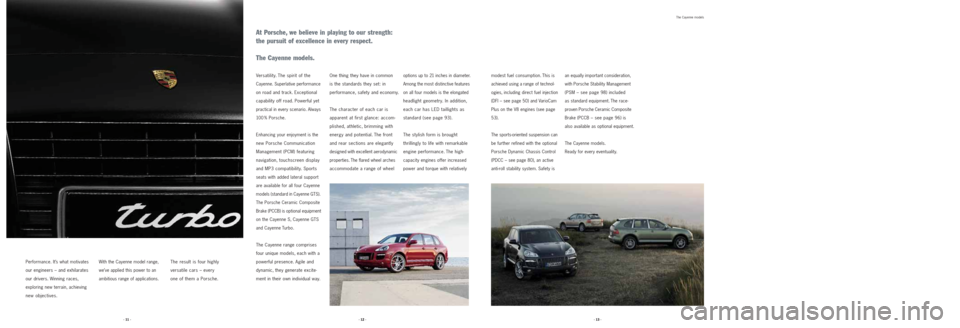
Versatility. The spirit of the
Cayenne. Superlative performance
on road and track. Exceptional
capability off road. Powerful yet
practical in every scenario. Always
100 % Porsche.
Enhancing your enjoyment is the
new Porsche Communication
Management (PCM) featuring
navigation, touchscreen display
and MP3 compatibility. Sports
seats with added lateral support
are available for all four Cayenne
models (standard in Cayenne GTS).
The Porsche Ceramic Composite
Brake (PCCB) is optional equipment
on the Cayenne S, Cayenne GTS
and Cayenne Turbo.
The Cayenne range comprises
four unique models, each with a
powerful presence. Agile and
dynamic, they generate excite-
ment in their own individual way.
· 12 · · 11 ·· 13 ·
Performance. It’s what motivates
our engineers – and exhilarates
our drivers. Winning races,
exploring new terrain, achieving
new objectives.
With the Cayenne model range,
we’ve applied this power to an
ambitious range of applications.
The result is four highly
versatile cars – every
one of them a Porsche.
At Porsche, we believe in playing to our strength:
the pursuit of excellence in every respect.
The Cayenne models.
The Cayenne models
One thing they have in common
is the standards they set: in
performance, safety and economy.
The character of each car is
apparent at first glance: accom-
plished, athletic, brimming with
energy and potential. The front
and rear sections are elegantly
designed with excellent aerodynamic
properties. The flared wheel arches
accommodate a range of wheel
options up to 21 inches in diameter.
Among the most distinctive features
on all four models is the elongated
headlight geometry. In addition,
each car has LED taillights as
standard (see page 93).
The stylish form is brought
thrillingly to life with remarkable
engine performance. The high-
capacity engines offer increased
power and torque with relatively
modest fuel consumption. This is
achieved using a range of technol-
ogies
, including direct fuel injection
(DFI – see page 50) and VarioCam
Plus on the V8 engines (see page
53).
The sports-oriented suspension can
be further refined with the optional
Porsche Dynamic Chassis Control
(PDCC – see page 80), an active
anti-roll stability system. Safety is an equally important consideration,
with Porsche Stability Management
(PSM – see page 98) included
as standard equipment. The race-
proven Porsche Ceramic Composite
Brake (PCCB– see page 96) is
also available as optional equipment.
The Cayenne models.
Ready for every eventuality.
Page 7 of 95
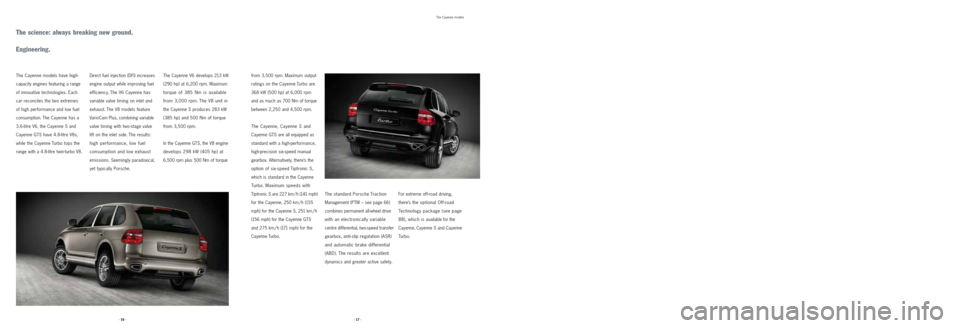
The standard Porsche Traction
Management (PTM – see page 66)
combines permanent all-wheel drive
with an electronically variable
centre differential, two-speed transfer
gearbox, anti-slip regulation (ASR)
and automatic brake differential
(ABD). The results are excellent
dynamics and greater active safety.
The Cayenne models
The Cayenne V6 develops 213 kW
(290 hp) at 6,200 rpm. Maximum
torque of 385 Nm is available
from 3,000 rpm. The V8 unit in
the Cayenne S produces 283 kW
(385 hp) and 500 Nm of torque
from 3,500 rpm.
In the Cayenne GTS, the V8 engine
develops 298 kW (405 hp) at
6,500 rpm plus 500 Nm of torque
from 3,500 rpm. Maximum output
ratings on the Cayenne Turbo are
368 kW (500 hp) at 6,000 rpm
and as much as 700 Nm of torque
between 2,250 and 4,500 rpm.
The Cayenne, Cayenne S and
Cayenne GTS are all equipped as
standard with a high-performance,
high-precision six-speed manual
gearbox. Alternatively, there’s the
option of six-speed Tiptronic S,
which is standard in the Cayenne
Turbo. Maximum speeds with
Tiptronic S are 227 km / h (141 mph)
for the Cayenne, 250 km / h (155
mph) for the Cayenne S, 251 km / h
(156 mph) for the Cayenne GTS
and 275 km / h (171 mph) for the
Cayenne Turbo.
Direct fuel injection (DFI) increases
engine output while improving fuel
efficiency. The V6 Cayenne has
variable valve timing on inlet and
exhaust. The V8 models feature
VarioCam Plus,combining variable
valve timing with two-stage valve
lift on the inlet side. The results:
high performance, low fuel
consumption and low exhaust
emissions. Seemingly paradoxical,
yet typically Porsche.
For extreme off-road driving,
there’s t
he optional Off-road
Technology package (see page
88), which is
available for the
Cayenne, Cayenne S
and Cayenne
Turbo.
The science: always breaking new ground.
Engineering.
The Cayenne models have high-
capacity engines featuring a range
of innovative technologies. Each
car reconciles the two extremes
of high performance and low fuel
consumption. The Cayenne has a
3.6-litre V6, the Cayenne S and
Cayenne GTS have 4.8-litre V8s,
while the Cayenne Turbo tops the
range with a 4.8-litre twin-turbo V8.
· 17 · · 16 ·
Page 10 of 95
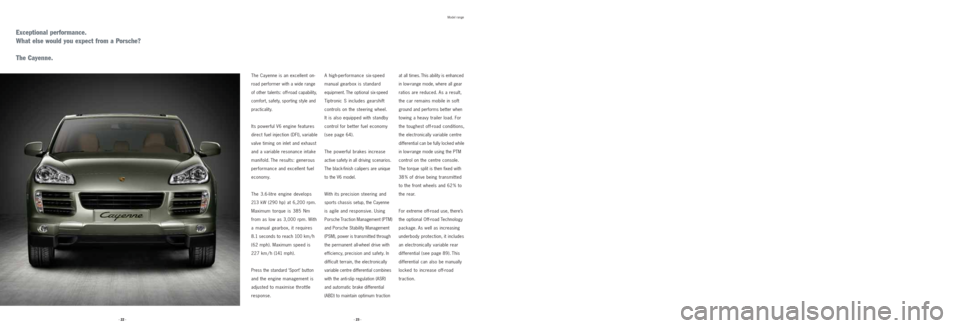
Model range
Exceptional performance.
What else would you expect from a Porsche?
The Cayenne.
A high-performance six-speed
manual gearbox is standard
equipment. The optional six-speed
Tiptronic S includes gearshift
controls on the steering wheel.
It is also equipped with standby
control for better fuel economy
(see page 64).
The powerful brakes increase
active safety in all driving scenarios.
The black-finish calipers are unique
to the V6 model.
With its precision steering and
sports chassis setup, the Cayenne
is agile and responsive. Using
Porsche Traction Management (PTM)
and Porsche Stability Management
(PSM), power is transmitted through
the permanent all-wheel drive with
efficiency, precision and safety. In
difficult terrain, the electronically
variable centre differential combines
with the anti-slip regulation (ASR)
and automatic brake differential
(ABD) to maintain optimum traction
at all times. This ability is enhanced
in low-range mode, where all gear
ratios are reduced. As a result,
the car remains mobile in soft
ground and performs better when
towing a heavy trailer load. For
the toughest off-road conditions,
the electronically variable centre
differential can be fully locked while
in low-range mode using the PTM
control on the centre console.
The torque split is then fixed with
38 % of drive being transmitted
to the front wheels and 62 % to
the rear.
For extreme off-road use, there’s
the optional Off-road Technology
package. As well as increasing
underbody protection, it includes
an electronically variable rear
differential (see page 89). This
differential can also be manually
locked to increase off-road
traction.
The Cayenne is an excellent on-
road performer with a wide range
of other talents: off-road capability,
comfort, safety, sporting style and
practicality.
Its powerful V6 engine features
direct fuel injection (DFI), variable
valve timing on inlet and exhaust
and a variable resonance intake
manifold. The results: generous
performance and excellent fuel
economy.
The 3.6-litre engine develops
213 kW (290 hp) at 6,200 rpm.
Maximum torque is 385 Nm
from as low as 3,000 rpm. With
a manual gearbox, it requires
8.1 seconds to reach 100 km / h
(62 mph). Maximum speed is
227 km / h (141 mph).
Press the standard ‘Sport’ button
and the engine management is
adjusted to maximise throttle
response.
· 23 · · 22 ·
Page 12 of 95

The Porsche ‘S’ has long been
a mark of heightened sports
performance. On the Cayenne S –
as on many cars before – it means
power, athleticism, more efficient
dynamics – even greater driving
pleasure.
To experience its effects, simply
drop down a gear on the six-speed
manual gearbox (option: six-speed
Tiptronic S) and open up the
throttle on the 4.8-litre V8 engine.
Thanks to direct fuel injection (DFI),
the effect is immediate with drive
transmitted to a set of 18-inch
Cayenne S II wheels. The car is
propelled to 100 km / h (62 mph) in
as little as 6.6 seconds. Maximum
speed is 252 km / h (157 mph).
The naturally aspirated V8 develops
283 kW (385 hp) at 6,200 rpm.
Maximum torque is 500 Nm
from 3,500 rpm. This exceptional
performance is, in part, achieved
with the aid of variable valve
timing and two-stage valve lift
(VarioCam Plus). This system is
also responsible for the smooth
running characteristics, significantly
improved fuel economy and lower
exhaust emissions.
The engine sound is typically
Porsche – even more so with the
optional sports exhaust system
(available in conjunction with
Tiptronic S). As well as enhancing
the acoustics of the car, it features
twin chrome-plated stainless
steel tailpipes. The sports exhaust
has a ‘Sport’ sound setting that
is automatically enabled when the
general ‘Sport’ mode is selected.
Reaches places that others can only dream of.
Like the heights of driving pleasure.
The Cayenne S.
The handling characteristics and
driving properties are exemplary
for a car of such versatility. Equally
impressive are the standard safety
systems, including larger brakes
with distinctive silver-finish calipers.
Porsche Stability Management (PSM)
is standard on all Cayenne models
and provides a further reduction in
braking distances (see page 98).
The Porsche Ceramic Composite
Brake (PCCB) is available as optional
equipment on the Cayenne S,
Cayenne GTS and Cayenne Turbo.
The driving dynamics can be
further enhanced with the optional
air suspension featuring Porsche
Active Suspension Management
(PASM – see page 76).
Model range
· 27 · · 26 ·
Page 14 of 95

Breaking new ground.
On the road.
The Cayenne GTS.
Drive is transmitted through a
high-performance six-speed manual
gearbox or optional six-speed
Tiptronic S. The GTS model has
a shorter final-drive ratio than
the Cayenne S, which increases
acceleration. The benchmark sprint
to 100 km / h (62 mph) requires
just 6.1 seconds (with standard
manual gearbox). Maximum
speed is 253 km / h (157 mph).
The engine sound is specially
enhanced by the standard sports
exhaust system.
Developing the Cayenne GTS was
an exercise in what we do best:
more performance, more agility,
a more immediate driving experi-
ence. In short: more sport – both
visually and technically – designed
exclusively for the road.
The 4.8-litre naturally aspirated
V8 features direct fuel injection
(DFI). It also includes a range
of performance enhancements
compared with the Cayenne S.
The revised intake manifold and
engine management system
enable greater power and
efficiency. The results: 298 kW
(405 hp) at 6,500 rpm and
500 Nm of torque at 3,500 rpm.
Another special feature on the
Cayenne GTS is the combination
of steel-sprung sports suspension
and Porsche Active Suspension
Management (PASM) as standard
(air suspension available as an
option). The ride height has been
lowered by 24 mm (20 mm
on optional air suspension) to
improve handling and high-speed
stability. The car’s cornering
potential is immediately apparent
from the standard 21-inch
Cayenne Sport wheels.
Model range
· 31 · · 30 ·
Page 16 of 95

Model range
More agility. More efficiency. More safety.
So far, it all makes perfect sense.
The Cayenne Turbo.
This enormous potential is trans-
mitted to the road through the stand-
ard six-speed Tiptronic S.Running
on 19-inch Cayenne Design
wheels,
the benchmark sprint to
100 km / h
(62 mph) is completed in just
5.1 seconds. At 210 km / h (131 mph),
the standard air suspen
sion is
automatically lowered to
increase
stability and aerodynamic
efficiency.
Maximum speed is 275 km / h
(171 mph).
Porsche Active Suspension
Management (PASM) continuously
modifies the damping force on
each wheel based on changing
road conditions and driving style.
The optional Porsche Dynamic
Chassis Control (PDCC) helps to
minimise body-roll when cornering.
This not only enhances occupant
comfort, it also improves contact
with the road. Pulse rate climbing. Shiver down
the spine. Both natural reactions
in a turbocharged Porsche.
The Cayenne Turbo is one of the
most remarkable examples of
the Porsche performance principle.
Blending power with comfort,
it does so in style without ever
compromising on either.
Start the ignition, and immediately
you sense the energy latent in
the 4.8-litre twin-turbo V8.
Featuring direct fuel injection (DFI),
it develops 368 kW (500 hp) at
6,000 rpm. Maximum torque
of 700 Nm is available between
2,250 and 4,500 rpm.Press the ‘Sport’ button on the
centre console and the throttle
becomes more responsive,
the engine more dynamic and
Tiptronic S more direct. At
the same time, Porsche Active
Suspension Management (PASM)
is also switching to ‘Sport’ mode.
The air suspension is automatically
lowered to the more streamlined
Low Level I.
· 35 · · 34 ·
Page 20 of 95
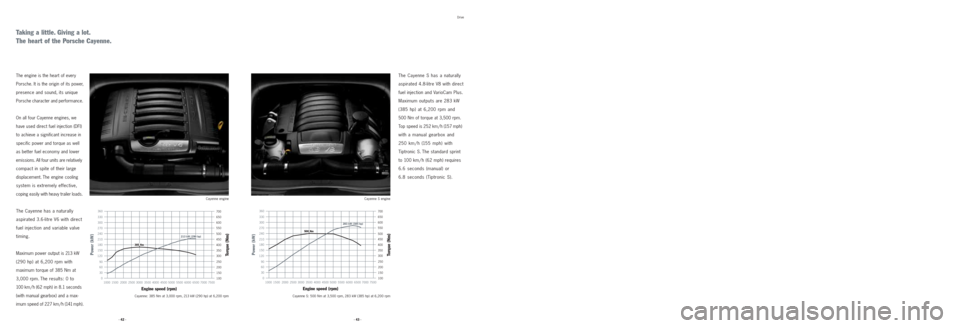
100 300 350
400
450
500 550 600
6500 30
60 90 120150
180 210 240 270
300
3301500
7500 2000 2500 3000 3500 4000 4500 5000 5500 6000 6500 7000
150 200
250
1000
Power (kW)Torque (Nm)
Engine speed (rpm)
360700
283 kW (385 hp)
500 Nm
100 300 350
400
450
500 550 600
6500 30
60 90 120150
180 210 240 270
300
3301500
7500 2000 2500 3000 3500 4000 4500 5000 5500 6000 6500 7000
150 200
250
1000
Power (kW)Torque (Nm)
Engine speed (rpm)
360700
213 kW (290 hp)
385 Nm
Cayenne: 385 Nm at 3,000 rpm, 213 kW (290 hp) at 6,200 rpm Cayenne S: 500 Nm at 3,500 rpm, 283 kW (385 hp) at 6,200 rpm
The engine is the heart of every
Porsche. It is the origin of its power,
presence and sound, its unique
Porsche character and performance.
On all four Cayenne engines, we
have used direct fuel injection (DFI)
to achieve a significant increase in
specific power and torque as well
as better fuel economy and lower
emissions. All four units are relatively
compact in spite of their large
displacement. The engine cooling
system is extremely effective,
coping easily with heavy trailer loads.
The Cayenne has a naturally
aspirated 3.6-litre V6 with direct
fuel injection and variable valve
timing.
Maximum power output is 213 kW
(290 hp) at 6,200 rpm with
maximum torque of 385 Nm at
3,000 rpm. The results: 0 to
100 km / h (62 mph) in 8.1 seconds
(with manual gearbox) and a max-
imum speed of 227 km / h (141 mph).
The Cayenne S has a naturally
aspirated 4.8-litre V8 with direct
fuel injection and VarioCam Plus.
Maximum outputs are 283 kW
(385 hp) at 6,200 rpm and
500 Nm of torque at 3,500 rpm.
Top speed is 252 km / h (157 mph)
with a manual gearbox and
250 km / h (155 mph) with
Tiptronic S. The standard sprint
to 100 km / h (62 mph) requires
6.6 seconds (manual) or
6.8 seconds (Tiptronic S).
Cayenne S engine
Drive
Taking a little. Giving a lot.
The heart of the Porsche Cayenne.
Cayenne engine
· 43 · · 42 ·
Page 21 of 95
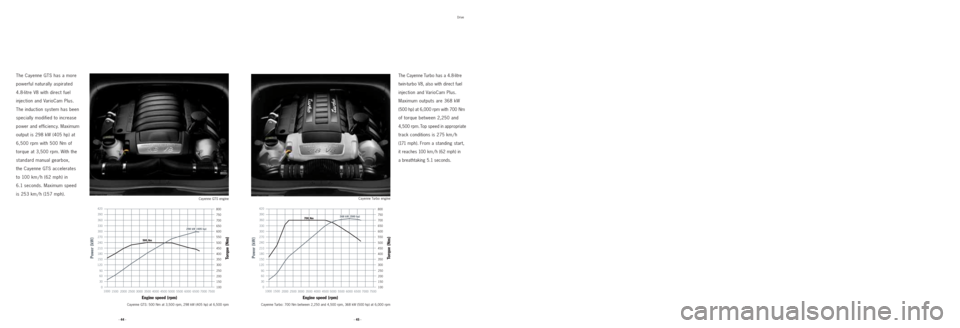
100 300 350
400
450
500 550 600
6500 30
60 90 120150
180 210 240 270
300
3301500
7500 2000 2500 3000 3500 4000 4500 5000 5500 6000 6500 7000
150 200
250
1000
Power (kW)Torque (Nm)
Engine speed (rpm)
360700
390750
298 kW (405 hp)
500 Nm
800420
100 300 350
400
450
500 550 600
6500 30
60 90 120150
180 210 240 270
300
3301500
7500 2000 2500 3000 3500 4000 4500 5000 5500 6000 6500 7000
150 200
250
1000
Power (kW)Torque (Nm)
Engine speed (rpm)
360700
390750368 kW (500 hp)700 Nm
800420
The Cayenne GTS has a more
powerful naturally aspirated
4.8-litre V8 with direct fuel
injection and VarioCam Plus.
The induction system has been
specially modified to increase
power and efficiency. Maximum
output is 298 kW (405 hp) at
6,500 rpm with 500 Nm of
torque at 3,500 rpm. With the
standard manual gearbox,
the Cayenne GTS accelerates
to 100 km / h (62 mph) in
6.1 seconds. Maximum speed
is 253 km / h (157 mph).
The Cayenne Turbo has a 4.8-litre
twin-turbo V8, also with direct fuel
injection and VarioCam Plus.
Maximum outputs are 368 kW
(500 hp) at 6,000 rpm with 700 Nm
of torque between 2,250 and
4,500 rpm. Top speed in appropriate
track conditions is 275 km / h
(171 mph). From a standing start,
it reaches 100 km / h (62 mph) in
a breathtaking 5.1 seconds.
Drive
Cayenne Turbo engine
Cayenne Turbo: 700 Nm between 2,250 and 4,500 rpm, 368 kW (500 hp) at 6,000 rpm Cayenne GTS engine
Cayenne GTS: 500 Nm at 3,500 rpm, 298 kW (405 hp) at 6,500 rpm
· 45 · · 44 ·
Page 22 of 95

440
400
360
320
280
24 0
20 0
160
120
80 900
850
800
750
700
650
600
550
500
450
2000 4000 6000
Our greatest motivation:
to exceed our own achievements.
Powerkit Cayenne Turbo.
The Porsche Turbo is a simple
concept: ultimate performance in
every respect. The Cayenne Turbo
continues this tradition with power,
dynamism and agility. This capability
can only be achieved when you’re
always striving to improve. Which
is why even the Cayenne Turbo
can offer increased power and,
with it, greater active safety.
The optional Powerkit Cayenne
Turbo increases maximum output
from 500 to 540 hp.
This is achieved using a new
intake manifold and a number
of modifications to the engine
management system. The result:
397 kW (540 hp) at 6,000 rpm.
Maximum torque is increased by
50 Nm to 750 Nm (between
2,250 and 4,500 rpm). Acceleration
to 100 km / h (62 mph) requires
just 4.9 seconds. Maximum speed
is 279 km / h (173 mph).
Even the engine compartment
immediately conveys the promise
of pure performance. Special
features include a throttle body
cover in carbon fibre and a plaque
in brushed aluminium. These are combined with a titanium-coloured
intake manifold with carbon inlays
and silver-coloured ‘turbo’ logo.
The propeller shaft has also been
revised to match the increased
loads. The overall result:
even greater exhilaration on
the racetrack, even greater
responsiveness on the road.
Drive
Powerkit Cayenne Turbo*
Fuel consumption**
Urban 22.5 l/100 km (12.6 mpg)
Extra urban 10.5 l/100 km (26.9 mpg)
Combined 14.9 l/100 km (19.0 mpg)
CO2emissionsCombined 358 g/km
· 47 · · 46 ·
397 kW
(540 hp)
Power (kW)
Torque (Nm)
Cayenne Turbo with Powerkit
Cayenne Turbo with standard engine
750 Nm
(2,250 – 4,500 rpm)
Engine speed (rpm)Cayenne Turbo engine with Powerkit
** Only available in conjunction with 19-inch Porsche wheels or larger (with requisite approval).
** Emissions were recorded in accordance with Directive 80/1268/ EC on standard vehicles as valid at the time of publication.
The respective figures were not recorded on individual vehicles and do not constitute part of the offer.
This data is provided solely
for the purposes of comparison between the respective models. For more information, pleasecontact your Porsche Centre.
Page 23 of 95
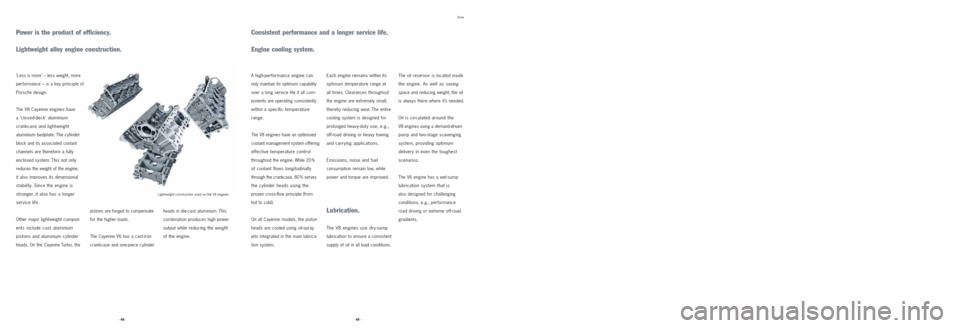
Power is the product of efficiency.
Lightweight alloy engine construction.
‘Less is more’ – less weight, more
performance – is a key principle of
Porsche design.
The V8 Cayenne engines have
a ‘closed-deck’ aluminium
crankcase and lightweight
aluminium bedplate. The cylinder
block and its associated coolant
channels are therefore a fully
enclosed system. This not only
reduces the weight of the engine,
it also improves its dimensional
stability. Since the engine is
stronger, it also has a longer
service life.
Other major lightweight compon-
ents include cast aluminium
pistons and aluminium cylinder
heads. On the Cayenne Turbo, the
pistons are forged to compensate
for the higher loads.
The Cayenne V6 has a cast-iron
crankcase and one-piece cylinderheads in die-cast aluminium. This
combination produces high power
output while reducing the weight
of the engine.
Drive
Lightweight construction used on the V8 engines
Consistent performance and a longer service life.
Engine cooling system.
Each engine remains within its
optimum temperature range at
all times. Clearances throughout
the engine are extremely small,
thereby reducing wear. The entire
cooling system is designed for
prolonged
heavy-duty use, e.g.,
off-road driving or heavy towing
and carrying applications.
Emissions, noise and fuel
consumption remain low, while
power and torque are improved.
Lubrication.
The V8 engines use dry-sump
lubrication to ensure a consistent
supply of oil in all load conditions.
The oil reservoir is located inside
the engine. As well as saving
space and reducing weight, the oil
is always there where it’s needed.
Oil is circulated around the
V8 engines using a demand-driven
pump and two-stage scavenging
system, providing optimum
delivery in even the toughest
scenarios.
The V6 engine has a wet-sump
lubrication system that is
also designed for challenging
conditions, e.g., performance
road driving or extreme off-road
gradients.
A high-performance engine can
only maintain its optimum capability
over a long service life if all com-
ponents are operating consistently
within a specific temperature
range.
The V8 engines have an optimised
coolant management system offering
effective temperature control
throughout the engine. While 20 %
of coolant flows longitudinally
through the crankcase, 80 % serves
the cylinder heads using the
proven cross-flow principle (from
hot to cold).
On all Cayenne models, the piston
heads are cooled using oil-spray
jets integrated in the main lubrica-
tion system.
· 49 · · 48 ·